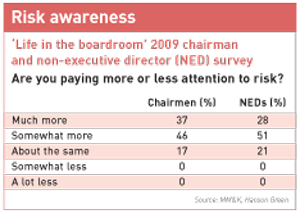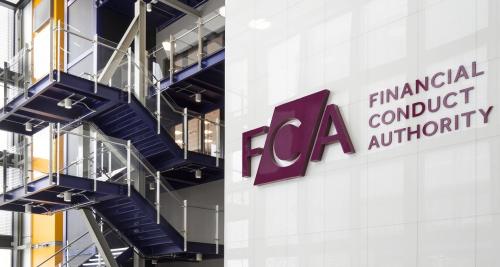Risk directors take center stage and credit risk is top priority for analysts
By all accounts, being a risk manager in the run-up to the credit crunch was a thankless task. Doing your job properly seems to have led to demotion or the sack, sometimes with a gagging order thrown in for good measure. How things have changed. For its 2008 results announcement, UK bank Barclays wheeled out group risk director Robert Le Blanc to present alongside CEO John Varley and finance director Chris Lucas. What’s more, Le Blanc spent longer at the podium than either of his more senior colleagues. In the topsy-turvy world of recession, risk has taken center stage.
How things have changed. For its 2008 results announcement, UK bank Barclays wheeled out group risk director Robert Le Blanc to present alongside CEO John Varley and finance director Chris Lucas. What’s more, Le Blanc spent longer at the podium than either of his more senior colleagues. In the topsy-turvy world of recession, risk has taken center stage.
Of course, banks have borne the brunt of investor scrutiny; their bloated balance sheets remain a worry for the investment community. But most companies – not just financials – have seen interest in risk and risk management shoot up of late.
‘Today companies are screened more deeply with respect to potential operational threats,’ comments Arvydas Noreika, an analyst at Nordic firm Orion Securities who specializes in healthcare companies. ‘In particular, investors want to examine all the risks related to a company’s debt situation. This is a key factor; sufficient data on this matter is one of the most important issues that helps investors make a final investment decision.’
Investors want more information on risk, more often. They also want to move away from the boilerplate language that has characterized much risk disclosure in the past. The issues may be different for each company, but the focus on risk is affecting listed firms of all sectors and sizes.
An odd star
Arguably, Barclays focused slightly too much on risk at its results presentation. Le Blanc’s speech was almost twice as long as Varley’s, clocking in at 27 minutes and 32 seconds. The Herald, a Scottish newspaper, reported that a whisper of ‘take the biscuits in with you’ went round the room when Le Blanc was brought out. A tad mean, perhaps, but it conveys the unusual aspect of a risk director presenting directly to investors and analysts.
‘I believe it’s unprecedented for the head of risk to be the main feature of a results presentation, and I’ve certainly never asked for direct access to such a person,’ comments Alex Potter, a banking analyst at investment bank Collins Stewart.
The turn of events, however, made the use of Le Blanc look smart. The very next day, Paul Moore, former head of risk at HBOS, a British mortgage lender that racked up losses of £10 bn ($14 bn) in 2008, accused his former employees of pursuing an overly aggressive strategy, disregarding his warnings and eventually replacing him with someone from a sales background with no experience of risk management. Suddenly risk was front-page news, although Barclays couldn’t have known this would be the case.
Credit check
Le Blanc’s presentation may not have been the most gripping, but it forced home the point that Barclays is focused on risk more than ever. And that’s something the investment community wants to hear as the global economy continues to bomb.
According to a recent survey, concerns over credit risk have caused the biggest shift in IR messaging in the last 12 months. Two thirds of respondents to ‘Global trends in IR’, an annual survey conducted by the Bank of New York Mellon in association with NIRI, say analyst questions have caused them to place more emphasis on this topic.
No other issue has had such a large impact on IR communications, reports the study. The findings confirm what has been assumed for many months, as banks continue to restrict lending and corporate bond prices remain high. Every week another company comes under pressure to pay down or refinance its debt, or both.
‘Companies are going to be under pressure to disclose exactly what their situation is in terms of financing,’ Mark Hynes, an IR consultant at communications specialists Radley Yeldar, told members of the UK’s IR Society recently. Naturally, investors are anxious. Reassuringly, the survey’s results indicate that IR professionals are responding en masse to this concern.
All systems go?
Beyond specific risks like debt, another high-profile concern is risk management. Some have been open about the need for radical change at their organizations. When called before a committee of UK MPs to discuss the banking crisis, Stephen Hester, chief executive of Royal Bank of Scotland (RBS), admitted there was plenty to do.
‘Frankly, the risk-management systems at RBS need a lot of change, and I cannot do it all in a couple of weeks, so we need to keep upgrading and improving,’ Hester told MPs. ‘We are putting in major changes as we speak, but it will take some time to get those absolutely right.’
Those calling for change have numerous and varied demands. Some say banking boards are too big; others want non-executives to step up to the plate and challenge more. The risks and systems applicable to each company are different.  IROs should plan to tackle these areas in face-to-face meetings with the investment community, as right now investors and analysts appear to hold little regard for written disclosure of risk-management systems. ‘I am unsure how we can capture this in written risk reports in any meaningful way without resorting to boilerplate language,’ notes one corporate governance analyst at a global asset manager. ‘Institutional investors typically glean this information in one-to-one settings.’
IROs should plan to tackle these areas in face-to-face meetings with the investment community, as right now investors and analysts appear to hold little regard for written disclosure of risk-management systems. ‘I am unsure how we can capture this in written risk reports in any meaningful way without resorting to boilerplate language,’ notes one corporate governance analyst at a global asset manager. ‘Institutional investors typically glean this information in one-to-one settings.’
This may change in 2009, as issuers, like Barclays, seek to put investors beyond all doubt that risk and risk management are top priorities. Companies are now under more pressure than ever to discuss their respective risks, especially credit risk. The constant barrage of bad economic data makes sure of that.
For now, what’s clear is that risk has risen dramatically in prominence, and not just among the investment community. HBOS’ failure has shot risk onto the front pages and into the perception of the public – a public that perhaps already is, or may soon be, one of your main shareholders.
Annual angst
Discussion of risk in the annual report has been widely neglected – but attitudes may be about to change, reports Tim Human
Market participants agree risk reporting in annual reports has been pretty poor up to now. Complaints especially focus on the use of boilerplate language to meet corporate governance guidelines.
‘Please tell your annual report writers to stop using generic risk-management controls and be more specific about risks to the company – and how they are mitigated,’ comments James Milne, a buy-side analyst in the European growth fund at New Star Asset Management.
What’s more, Richard Sheath, director of UK board consultancy Independent Audit, says he had to abandon an investigation into risk reporting among FTSE 100 firms as there were so few good examples.
Like risk itself, risk reporting appears to have been neglected by issuers and shareholders in the run-up to the credit crunch. It remains to be seen whether the market’s heightened interest in the topic will lead to better discussion of risks and risk management in 2009.
Possible improvements could include a better explanation of the governance culture within a company that allows risks to be discussed openly. As details emerge from the UK’s banking crisis, it appears boards were all-too ready to back aggressive strategies and risky deal-making being pushed by CEOs and chairmen.
Linking risks to other parts of the report, like the CEO’s statement or key performance indicators (KPIs), is a useful way to set out the information, suggests Mark Hynes, IR consultant at communications specialists Radley Yeldar. He highlights UK television company ITV’s 2007 annual report, in which risks are listed next to the KPIs they affect, as a good example. In a third column in the report, ITV describes its mitigation strategy for each risk.
In addition, investors and analysts say they want to hear about the systems companies have in place to identify future risks and opportunities, known as enterprise risk management. Diagrams outlining risk identification and reporting lines are also welcomed.
Of course, setting out the risks once a year only goes so far in allaying the concerns of the investment community, while institutional investors will typically extract the specific information they need in one-on-one meetings with issuers. With risk at the top of the agenda, however, the annual report isn’t a bad place to start.
‘This year understanding the downside risk is going to be absolutely top of investors’ agendas,’ concludes Hynes.
Risk reporting tips
Top marks
- Clear, easy-to-understand summary of major risks
- Explanation of priorities behind risk management
- Identification of likely future risks and uncertainties
- Assessment of potential impact on value
Low marks
- Compliance-based risk-management reporting
- Information buried in back of the report
- No clear headline risks
- No discussion of how risks are being managed










